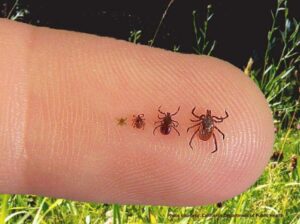For years, we have warned of Lyme disease [1] and that it very well could be an up-and-coming epidemic [1] to look out for. Lyme is a tick-borne disease and one of the fastest growing infectious diseases in the country and one of the most difficult to diagnose.
In fact, In fact, from 2007 to 2021, private insurance claim lines [2] with Lyme disease diagnoses rose 357% in rural areas and 65% in urban areas. This disease has recently taken a backseat to COVID-19, monkeypox, and many other new diseases, such as the Laygna virus. [3]
Related: Five Tick-Borne Diseases That All Americans Should Be Aware Of [4]
According to the CDC [5], Lyme disease is the most common vector-borne disease in the United States. Lyme disease is caused by the bacterium Borrelia burgdorferi and, rarely, Borrelia mayonii [6]. It is transmitted [7] to humans through the bite of infected black-legged ticks. This disease is so common that 1 in 7 people have been infected with it and simply don’t know it.
If left untreated, the infection can spread to joints, the heart, and the nervous system. But Lyme disease can be treated successfully with antibiotics. It is often diagnosed off symptoms only, so if you live in an area with many ticks, be aware of them.
Early signs and symptoms (3-30 days After a Tick Bite)
- Untreated Lyme disease can produce a wide range of symptoms, depending on the stage of infection. These include fever, rash, facial paralysis, and arthritis.
- Fever, chills, headache, fatigue, muscle and joint aches, and swollen lymph nodes may occur in the absence of rash
- Erythema migrans (EM) rash (see photos):
- Occurs in approximately 70 to 80 percent of infected persons
- Begins at the site of a tick bite after a delay of 3 to 30 days (average is about seven days)
- Expands gradually over several days reaching up to 12 inches or more (30 cm) across
- May feel warm to the touch but is rarely itchy or painful
- Sometimes clears as it enlarges, resulting in a target or “bull’s-eye” appearance
- May appear on any area of the body
- Does not always appear as a “classic” erythema migrans rash
- Later signs (Days to months after a tick bite)
- Fever, chills, headache, fatigue, muscle and joint aches, and swollen lymph nodes may occur in the absence of rash
- Erythema migrans (EM) rash (see photos):
- Occurs in approximately 70 to 80 percent of infected persons
- Begins at the site of a tick bite after a delay of 3 to 30 days (average is about 7 days)
- Expands gradually over several days reaching up to 12 inches or more (30 cm) across
- May feel warm to the touch but is rarely itchy or painful
- Sometimes clears as it enlarges, resulting in a target or “bull’s-eye” appearance
- May appear on any area of the body
- Does not always appear as a “classic” erythema migrans rash
- Photos of Rashes
The best way to help keep yourself safe is to prevent Lyme disease or a tick bite in the first place. You should know where ticks like to live in grassy, brushy, or wooded areas, or even on animals. Spending time outside walking your dog, camping, gardening, or hunting could bring you in close contact with ticks. Many people get ticks in their own yard or neighborhood. Before going outside, you can pre-treat clothing and gear with products containing 0.5% permethrin. [8] Permethrin can be used to treat boots, clothing, and camping gear and remain protective through several wash cycles. Alternatively, you can buy permethrin-treated clothing and gear. [9]
Reduce the tick population in your area by using pesticides. Use insect repellent when outside, and make sure you check for ticks in a timely manner once you return home.
